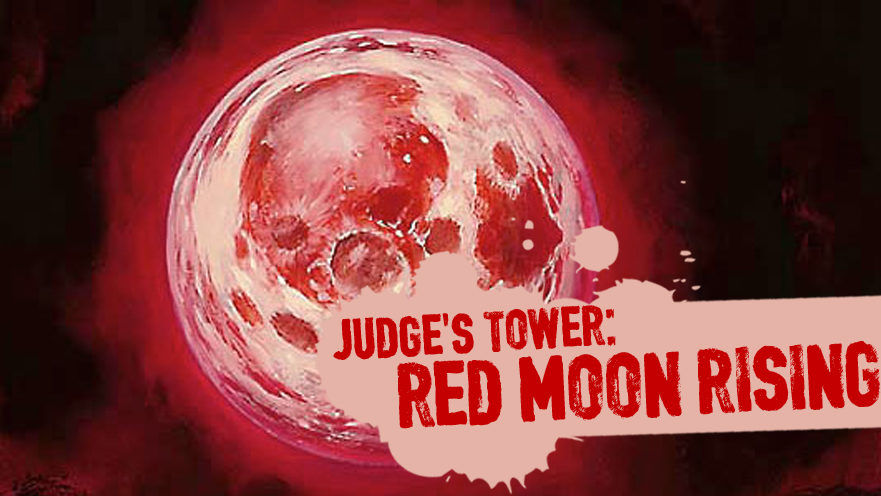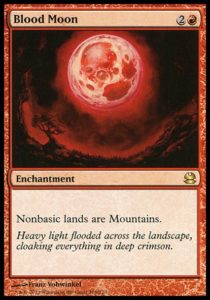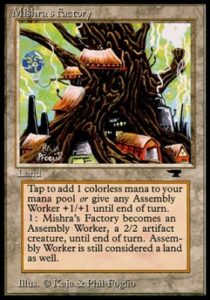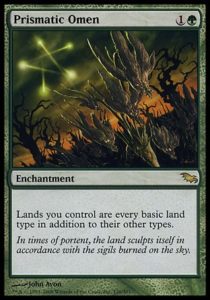Hey all, welcome back to Judge’s Tower! Enough of you liked the last one of these I wrote, so as promised (or threatened, depending on your point of view), today we’re going to deal with one the bigger “rules headache” cards out there – Blood Moon!
At first glance, Blood Moon seems innocuous enough. Just four simple words of Oracle text: “Non-basic lands are Mountains.” Easy, right? It just does what it says, so what’s the problem?
The problem, as it almost always is, is that Magic keeps printing more and more cards, and they all have to interact with each other. Blood Moon was originally printed in The Dark, and the trickiest interaction it had back then was probably with Mishra’s Factory. Speaking of which…
SCENARIO 1:
Amy is playing against Ned in a Legacy match. Amy is getting in with her hard-cast Simian Spirit Guide (sometimes, you do what you have to do to win). On Ned’s turn, he plays a Mishra’s Factory, stymying Amy’s next attack. Amy draws for her turn and casts Blood Moon. In response, Ned animates his Mishra’s Factory. When Blood Moon resolves, what happens to Mishra’s Factory?
ANSWER:
For the rest of the current turn, Mishra’s Factory is a 2/2 Artifact Creature Land – Mountain Assembly Worker with no other abilities. Once the turn ends and we move into Cleanup, it will become a Land – Mountain. Ned can still block for this turn, but will need to find another answer quick to deal with the Ape Spirit.
Blood Moon only modifies one specific thing on any non-basic land: it wipes away whatever subtype may be there, and replaces it with “Mountain.” Then, the rules kick in – specifically 305.6 and 305.7 in the Comprehensive Rules.
Rule 305.6 defines the basic land types (Plains, Island, Swamp, Mountain, and Forest). It also states that any land with a basic land type can tap for the appropriate color of mana. 305.7 is the real kicker for Blood Moon, and is important enough that I’m just going to put (most) of the actual text of the rule here:
“If an effect sets a land’s subtype to one or more of the basic land types, the land no longer has its old land type. It loses all abilities generated from its rules text, its old land types, and any copy effects affecting that land, and it gains the appropriate mana ability for each new basic land type. Note that this doesn’t remove any abilities that were granted to the land by other effects. Setting a land’s subtype doesn’t add or remove any card types (such as creature) or supertypes (such as basic, legendary, and snow) the land may have.”
The big bits here are that Blood Moon will effectively wipe out the text box of Mishra’s Factory, but doesn’t stop the ability turning it into a creature for the remainder of the turn.
So, with that in mind…
SCENARIO 2:
Same players, different game. Ned casts Blood Moon. On her turn, Amy plays Dryad Arbor. What is Dryad Arbor once it’s on the battlefield?
ANSWER:
Dryad Arbor is a 1/1 Green Creature Land – Mountain Dryad that taps for Red (but is still summoning sick – a phrase which doesn’t appear in the rules, but that’s a whole other thing).
Everything in the above situation still applies – the only wrinkle is the fact that Dryad Arbor has a color indicator, which will always make it Green even though its text box is wiped out.
There are a couple of other lands that follow this same basic situation which come up a decent amount, Darksteel Citadel and Inkmoth Nexus being the most common.
So now let’s move on to something a little more interesting:
SCENARIO 3:
Amy and Ned, at it again. On his turn, Ned once again plays his Blood Moon. On her turn, Amy, smiling, plays a Forest and casts Prismatic Omen. What happens to all the non-basic lands?
ANSWER:
This one comes down to timestamps! When two cards are trying to affect the same thing at the same time, the newest one always wins. From the Comprehensive Rules (613.6, for those keeping track):
“…determining which order effects are applied in is usually done using a timestamp system. An effect with an earlier timestamp is applied before an effect with a later timestamp.”
So what’s actually happening? Both Blood Moon and Prismatic Omen are trying to change the subtype of the lands in play. If the effects in question both affect the same objects in the same layer (don’t worry, we’ll end up discussing layers a lot throughout this column), then both still technically apply. In the example above, Blood Moon turns all non-basic lands into Mountains, then Prismatic Omen turns all lands into all basic land types. If we reverse the order they enter, then Prismatic Omen turns all lands into all basic land types, and then Blood Moon would turn all non-basics into Mountains.
What about a card like Urborg, Tomb of Yawgmoth? That’s also trying to modify land types, so timestamps should still apply against a Blood Moon in play, right?
Nope! Since Urborg is itself a land, it’s always going to end up getting hit by Blood Moon. Whether it comes down before or after the red enchantment, Urborg will always end up being a Mountain that has no other text, and therefore does not end up making anything a Swamp.
Aaaaaaand that pretty much covers it! Not that scary, right? Blood Moon is one of those cards that seems like it would cause all kinds of problems, but, as I’ll likely say again and again, knowing the reasons why things work makes everything much simpler.
Header design: Justin Treadway
Header art: “Blood Moon” by Franz Vohwinkel

Chris is the Marketing Communications Coordinator (and editor of the blog) at Card Kingdom. He would like to apologize to his son for not holding onto more cards from when he first started playing, as that likely would have paid for college. He enjoys pretty much all formats of Magic, but usually ends up playing decks that make other people dislike playing those formats with him.





